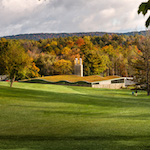If you live in a major metropolitan area, you know how infuriating traffic jams can be. A bottleneck on the way to or from work is a nuisance at best and an act of torture at worst. Imagine, then, how devastating gridlock would be if you weren’t just trying to get to the office but rather to date night with your spouse—and if you and your spouse were somehow also the last couple on Earth.
That’s probably how fish feel in Washington State. There, endangered species such as salmon and steelhead must swim upstream to reach their traditional spawning grounds. Along the way, they often encounter their own traffic jams, caused by deteriorating culverts, dilapidated bridges, and other barriers that block the passage of fish from point A to point B, hindering state and federal recovery efforts.
Faced with such obstacles, the fish depend for their survival on experts who can restore their natural habitat by removing the barriers that restrict passage. Morgan & Son Earthmoving, Inc. of Ellensburg, Washington, is one such expert. Here, in a variety of ways, president Dan Morgan illustrates the problem and how his company is engineering solutions.

From Roads to Rivers: A Family History
Morgan’s father, J. P., and grandfather John founded Morgan & Son Earthmoving in 1957. The company’s origins, however, reach much further back.
“It really started with my great grandfather August Thisius,” says Morgan, who, along with his sister, Laurie Morgan Bender, succeeded his parents as one of the company’s owners in 2006. “He was quite an entrepreneur. He had farmland, lumberyards, cattle and slaughterhouses, and real estate—all kinds of stuff—back in the 1920s. He also had a sawmill that they had set up in various locations in the woods of Central Washington. That was [when] you brought the mill to the woods instead of bringing the trees to town. Back in those days, they did logging with horses; it was about that time that horses started going away and bulldozers started coming in.”
When he began working on the farm, John—August’s son-in-law—purchased the first dozer tractor in Washington State’s Yakima River Valley, which he used for many years to assist with building roads to service the family’s sawmill. Meanwhile, J. P. grew up and enlisted in the military. When he got out of the service and was trying to decide on a career, he had the idea to level land for other farms and sawmills as his father had long been doing for his own. Soon after, J. P. and his father formed a legal partnership to officially start Morgan & Son Earthmoving, which, for the past 57 years, has specialized in road construction and maintenance for farms and forests.
Fast-forward to 1999: Washington State passes the Salmon Recovery Act to restore fish runs for endangered and threatened species of salmon and steelhead. “The Salmon Recovery Act required all the forest roads in the state to be brought up to new standards for fish passage,” Morgan says. “Landowners are required to upgrade their roads and either abandon them—bring them back to preroad conditions—or make the streams [that the roads cross] passable for fish.”
Its experience in road construction, particularly in remote logging areas, made Morgan & Son Earthmoving uniquely equipped for the task of helping landowners comply with salmon recovery laws. That’s how the company got into the fish-habitat-restoration business.
Moving More Than Earth
Since 2000, more than 5,000 fish-passage barriers in Washington streams have been replaced with fish-friendly culverts and bridges, opening more than 4,800 miles of fish-spawning habitat statewide, according to the Washington State Salmon Recovery Funding Board.
Reflecting on his own contributions, Morgan realizes he has moved a lot more than earth with his excavators; he has moved the needle on environmental sustainability. “We’ve improved the ecosystem of the forest,” he says. “Not only am I providing my family an income, but I can look back on our work and be proud of what we did. I’ve got a six-year-old son, and if we can leave the world a better place for him, that’s a pretty good accomplishment, I think.”

Fish Facts
Morgan & Son Earthmoving restores habitats for both public and private landowners, including timber companies, the US Forest Service, and the Washington State Department of Natural Resources. At the end of the day, however, the company’s most important stakeholders are the fish who benefit from its work. “I’m not a biologist, but I can tell you that [habitat restoration] is a huge issue,” Morgan says. Consider the following:
Salmon are valuable
In Washington State alone, commercial fishing generates approximately 60,000 jobs, according to the National Marine Fisheries Service, which also says salmon generate nearly $25 million in annual commercial fishing revenue along the West Coast.
Salmon are scarce
In many salmon runs along the West Coast, the populations of wild salmon stand at less than 10 percent of their historical numbers, the American Fisheries Society says. What’s more, less than 40 percent of salmon stocks are in a healthy condition, according to the Washington Department of Fish & Wildlife.
Salmon are stressed
Salmon are at risk of extinction in three-quarters of Washington State, according to the Washington State Recreation and Conservation Office. Exacerbating threats against them are population growth—the state’s population is expected to grow from 7 million in 2014 to more than 8 million by 2030, according to the Washington Office of Financial Management—and climate change, which is gradually depleting and heating the water sources on which salmon rely.

Salmon Survival
According to Washington State’s report, “Statewide Strategy to Recover Salmon,” salmon need the following to survive:
- Adequate amounts of cool, clean, and well-oxygenated freshwater so that the fish can breathe
- Fully functioning riparian corridors with large woody debris in the stream channel
- High-quality estuarine, nearshore, and marine habitats such as logjams
- Adequate supply of food, cover, and refuge from predators, including birds and mammals
- Unimpeded access to and from freshwater

Location: Little Naches River, near Chinook Pass, WA
Client: US Forest Service
Year: 2012
Objective: Restore a flooded road with fish passage in mind
Anatomy of a Project: Little Naches River
1. Floods from the Little Naches River wash away a stretch of Forest Service Road 1900—just off Highway 410—under which the river flows. The US Forest Service hires Morgan & Son Earthmoving to restore the road in its original footprint.
2. First, the company digs a diversion for the river, temporarily rerouting it to give crews access to the riverbed during construction. The diversion is lined with a plastic membrane to prevent seepage into otherwise dry soil.
3. Conservationists “defish” the dry riverbed, removing any stray fish from standing-water pools in order to ensure their survival.
4. Morgan & Son lines the riverbed with riprap—rock or rubble used to armor shorelines—and installs engineered logjams consisting of trees that still have their root systems intact. Laid in a deliberate manner, these logjams will prevent bridge scour and also create shaded fish habitats.
5. The company rebuilds the washed-out road. Meanwhile, in a small tributary upstream, it replaces a 36-inch culvert with a 24-foot bottomless box culvert, securing greater passage for fish.
6. Morgan & Son replants disturbed trees and vegetation, which will provide additional shade that will keep the water cool enough to sustain fish.
7. Finally, the company reroutes the river from the temporary diversion back to its original channel beneath the road, which is now built in a manner that protects the integrity of the local fish habitat.
Capable Culverts
Culverts—tunnels that carry streams under roads—are the primary obstacle to salmon survival in Washington State, according to Morgan, because fish often have trouble traversing them in order to access upstream spawning grounds. Common problems include drops at culvert inlets and outlets; excessive water velocities; physical barriers in the culvert barrel such as weirs, baffles, and debris; and depths too shallow for fish to swim.
“A lot of projects we do [involve] constructing a new road or reconstructing an old one,” Morgan says. “Often, a major item in [a reconstruction] project is to replace a culvert with either a bridge or a bottomless arch pipe—something that puts the stream back to its original width, restoring the entire streambed instead of choking it down into a pipe that prevents fish from swimming upstream.”


